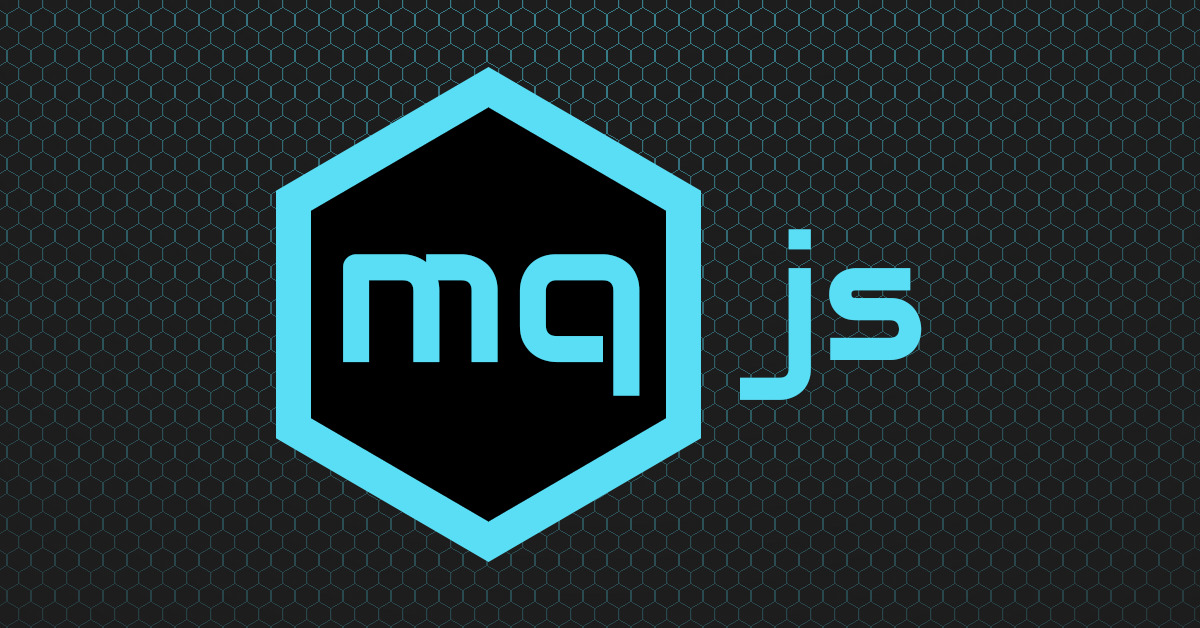mq-js was inspired by the mq-scss Sass mixin. I wanted to use media queries in JavaScript in a similar sort of way to how I was using media queries in my Sass code.
Full documentation for mq-js can be found at https://dan503.github.io/mq-js/
// MQ-JS
if (mq.inside(600, 1000)) {
// Functionality for screens between 600px and 1000px
}// MQ-SCSS
@include mq(inside, 600px, 1000px) {
// Styles for screens between 600px and 1000px
}Quick start guide
This documentation assumes that you have the ability to use ES6 JavaScript syntax in your project. mq-js will work in environments that don't support es6 JavaScript syntax however the syntax will be different to what is documented. View the full documentation for ES5 (IE friendly) examples.
If you are new to Node and npm, read this beginners guide on how to get set up. You will also need JavaScript bundling software such as Browserify, Rollup, or Webpack integrated into your build process for mq-js to work.
Once that is all set up, install mq-js using npm.
npm install mq-js --save
Now, create this simple mq.js file to set up your website breakpoints.
///////////////////
// "mq.js" file //
/////////////////
import MQ from 'mq-js'
// Define your Site break points here
const bp = {
small: 600,
medium: 980,
large: 1200,
}
// Creates the media query functions
const mq = new MQ(bp)
// Export mq by default
export default mq
// Gives easy access to your site breakpoints
export { mq, bp }Now import the mq variable into your main/component JavaScript file.
////////////////////////
// Component js file //
//////////////////////
// Import the mq variable that was created in the setup stage
import mq from '../mq'
// Alternatively import both the mq variable and the website breakpoints
// (Use one line or the other, do not use both import statements)
import { mq, bp } from '../mq'
document.querySelector('#button').onclick = function (e) {
e.preventDefault()
// Use your breakpoints by parsing in a string
mq.min('medium', (screen_size) => {
this.classList.toggle('-active')
// Log the screen height, width and ratio at the time the button was clicked
console.log(screen_size)
})
// Alternatively, use it in an if statement
if (mq.max('small')) {
// Do stuff for screens that are up to (and including) the "small" breakpoint width
}
// You can also use custom values
if (mq.min(1000)) {
// Do stuff for screens that are greater than 1000px wide
}
// If you imported the breakpoints, you can use tweaked versions of them
if (mq.inside(bp.small + 50, bp.medium - 100)) {
// Do stuff for screens that are between the "small" breakpoint + 50px
// and the "medium" breakpoint - 100px
}
}Note: mq.max is inclusive of the given screen size and mq.min is exclusive of the given screen size. This is to avoid any potential 1px overlap issues where both statements return true at the same time. It is also designed to align with how mq-scss works.
It is also worth noting that you can save your breakpoints into a json file and import that instead. This can make the breakpoints a bit more portable.
{
"//": "breakpoints.json file",
"small": 600,
"medium": 980,
"large": 1200
}///////////////////
// "mq.js" file //
/////////////////
import MQ from 'mq-js'
// Retrieve your site break points
import bp from './breakpoints.json'
const mq = new MQ(bp)
// Export mq by default
export default mq
// Easier access to your site breakpoints
export { mq, bp }Core methods
Note: You can add Width to the end of any of those methods and it will still be valid. For example, it is safe to use mq.minWidth instead of mq.min. The mq.minWidth method has identical functionality to mq.min.
Plugins
Height plugin
import 'mq-js/plugins/height'The height plugin provides these methods:
- mq.minHeight
- mq.maxHeight
- mq.insideHeight
- mq.outsideHeight
Read the full height plugin documentation.
Orientation plugin
import 'mq-js/plugins/orientation'The orientation plugin provides these methods:
- mq.orientation
Read the full orientation plugin documentation.
Ratio plugin
import 'mq-js/plugins/ratio'The ratio plugin provides these methods:
- mq.ratio
- mq.minRatio
- mq.maxRatio
- mq.insideRatio
- mq.outsideRatio
Read the full ratio plugin documentation.
reactTo plugin
import 'mq-js/plugins/reactTo'This gives you access to:
- mq.reactTo
This plugin is a bit different. The primary purpose of this plugin is to fire off a function when a media query either enters or leaves a defined screen size range.
It takes a function that returns an mq-js screen-check result as it's first parameter and a callback function as it's second parameter. It will then call the callback function every time the screen-check result changes from true to false or false to true.
mq.reactTo(
() => mq.inside(800, 1000),
(is_active, screen_size) => {
// is_active = did "mq.inside(800, 1000)" return true?
// screen_size = an object holding the screen height, width,
// and ratio (ratio in both string and number format) at the
// point when the screen crossed an mq boundary
console.log(is_active, screen_size)
}
)See a reactTo plugin demo in the full documentation.
The mq-js change log is available on the mq-js GitHub releases page
